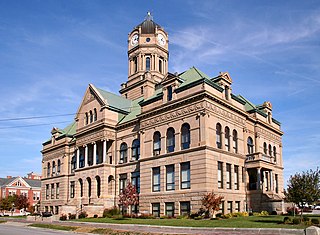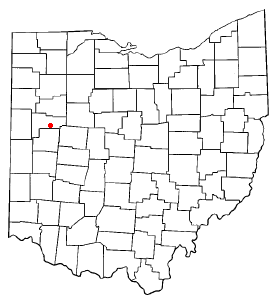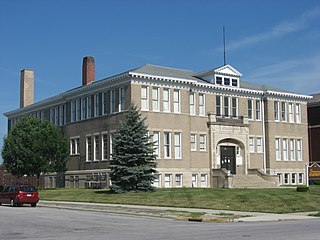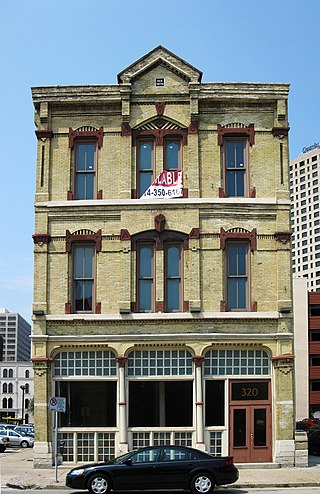
Auglaize County is a county in Northwestern Ohio, United States of America. As of the 2020 census, the population was 46,442. Its county seat and largest city is Wapakoneta.

Wapakoneta is a city in and the county seat of Auglaize County, Ohio, United States. Located along the Auglaize River, the city is about 56 miles (90 km) north of Dayton and 83 miles (134 km) south of Toledo. The population was 9,957 at the 2020 census. It is the principal city of the Wapakoneta micropolitan area, which is included in the Lima–Van Wert–Celina combined statistical area.

Union Township is one of the fourteen townships of Auglaize County, Ohio, United States. The 2020 census found 1,746 people in the township.

Fryburg is an unincorporated community located in central Pusheta Township, Auglaize County, Ohio, United States.

The Auglaize County Courthouse is located between West Mechanic, Willipie, West Pearl and Perry Streets in downtown Wapakoneta, Ohio, United States. Completed in 1894, it is listed on the National Register of Historic Places.

The Bona Allen Company is a tannery and leather goods factory that opened in 1873 in Buford, Georgia. It became the nation's largest producer of hand-tooled saddles, bridles, horse collars, postal bags, cowboy boots, and shoes and had a contract to supply the sporting equipment giant, Spalding, with raw material for the manufacture of baseballs and baseball mitts. Starting in the early 20th century Bona Allen saddles were offered in the Sears Mail Order catalog under a variety of names. The Bona Allen Company was owned by Bonaparte Allen Sr. Also known as the Bona Allen Shoe and Horse Collar Factory, the factory closed in 1981 after a fire, and the main tannery building was added to the National Register of Historic Places on January 3, 2005. It is located at 554 West Main Street. After another fire on February 10, 2015, firefighters allowed the building to burn itself down.

St. Patrick's Church is an historic Roman Catholic church in Glynwood, an unincorporated community in Moulton Township, Auglaize County, Ohio, United States. Located north of U.S. Route 33 between St. Marys and Wapakoneta, the church was built in 1883 in the Gothic Revival style. It is one of many large Catholic churches in a region of rural western Ohio known as the "Land of the Cross-Tipped Churches," which was settled by primarily Catholic immigrants during the nineteenth century.

The former Blume High School is a historic building in downtown Wapakoneta, Ohio, United States. It was the first exclusive home of Wapakoneta High School. Prior to that time, WHS was housed with other grades.

The First Presbyterian Church of Wapakoneta is a historic former church building in downtown Wapakoneta, Ohio, United States. A small brick building located along Main Street west of the Auglaize County Courthouse, it is the oldest Protestant church building in Auglaize County and the oldest church building of any faith in the city of Wapakoneta. It is historically significant as west-central Ohio's only example of Greek Revival architecture with distyle in antis construction, in which two columns are located in the opening between pilasters.

Holy Rosary Catholic Church is a Roman Catholic parish on the east side of St. Marys, Ohio, United States. Established in 1852, the church has been recognized for its historic 1860s church building, which was demolished amid a period of growth in the 1970s and replaced with a modernist structure.

St. Joseph's Catholic Church is a historic Roman Catholic church in Wapakoneta, Ohio, United States. Built in 1910, this church is home to an active Catholic parish, and it has been declared a historic site because of its well-preserved Romanesque Revival architecture.

The Hugh T. Rinehart House is a historic house located near Uniopolis in Union Township, Auglaize County, Ohio, United States. A brick structure built in 1861, it was once the home of one of the most prominent citizens of early Auglaize County. It has been designated a historic site because of its high degree of preservation.

The Minster Elementary School is a historic Catholic school building in Minster, Ohio, United States. Built in the early twentieth century, it has been recognized as a historic site.

The John H. Nichols House is a historic house in downtown Wapakoneta, Ohio, United States. Built in 1865, it is Wapakoneta's oldest example of the Greek Revival style of architecture. Among its leading features are a three-bay facade with a prominent gable, large entablature, and cornices under the roof, several large windows on the front and sides, and a trabeated entryway framed by several sidelights and a transom supported by two brackets.
S.B. Foot Tanning Company is a leather production facility located in Red Wing, Minnesota. It processes leather for use in the crafting of shoes, boots, belts, and leather accessories. In 2010, the factory processed nearly 6 million linear feet of hides. S.B. Foot Tanning Company is a wholly owned subsidiary of Red Wing Shoes Company, Inc. and is the principal supplier of leather to its shoe manufacturing plants. The company also supplies over 1.5 million linear feet of leather for use in the production of military footwear per year, extending a tradition that began with World War I, when the tannery supplied boot leathers for the construction of soldier boots.

The Tannery is a historic tannery building constructed by the colonial Moravians in Bethlehem, Northampton County, Pennsylvania. It is a limestone building built in 1761, and is part of the Bethlehem Colonial Industrial Quarter.

The Wisconsin Leather Company Building was built in 1874 in Milwaukee, Wisconsin as the central office and store of one of the first leather companies established in Milwaukee and by the 1870s one of the largest. It was added to the National Register of Historic Places in 2005.

Haw Creek Leather Company is a historic factory building located at Columbus, Indiana. It was built between 1914 and 1916, and is a two-story, brick industrial building. It sits on a raised basement and has a flat roof. It features arched window openings. The Haw Creek Leather Company operated a tannery at this location until 1955.

Ludwig Buchholz's Tannery was a leather complex factory which operated from 1845 to 1992 in Bydgoszcz. The plot and the administrative building are now used by the Private University of Economy of Bydgoszcz.

The Walker's Point Historic District is a mixed working-class neighborhood of homes, stores, churches and factories in Milwaukee, Wisconsin, with surviving buildings as old as 1849, including remnants of the Philip Best Brewery and the Pfister and Vogel Tannery. In 1978 it was added to the National Register of Historic Places. The NRHP nomination points out that Walker's Point was "the only part of Milwaukee's three original Settlements to reach the last quarter of the Twentieth Century with its Nineteenth and early-Twentieth Century fabric still largely intact," and ventures that "For something similar, one would have to travel to Cleveland or St. Louis if, indeed, so cohesive and broad a grouping of...structures still exists even in those cities."























